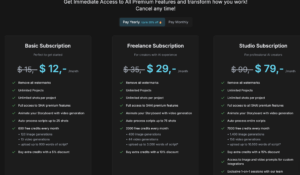This critical comparison reveals the dramatic transformation that AI technology brings to filmmaking workflows, demonstrating why industry professionals increasingly abandon manual approaches for intelligent automation. The Shai vs traditional methods analysis showcases revolutionary improvements in speed, cost-effectiveness, and creative quality that define modern production standards.
Shai pre-production represents a fundamental paradigm shift from labor-intensive manual processes to AI-powered workflows that deliver professional results in minutes rather than weeks. Moreover, AI vs traditional pre-production comparisons consistently favor automated solutions that eliminate traditional barriers while maintaining superior creative outcomes and professional quality standards.
Understanding Shai efficiency advantages enables filmmakers to make informed decisions about their production workflows while maximizing creative potential within budget constraints. Furthermore, Shai Creative’s AI storyboard generator demonstrates how cutting-edge technology can transform time-consuming manual tasks into rapid, automated processes that enhance rather than compromise creative vision.
Traditional Pre-Production: The Old Way
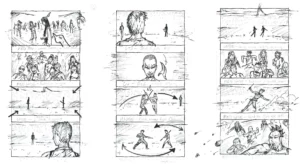
Manual Storyboard Creation Challenges
Traditional storyboard development requires hiring professional artists who charge $100-500 per panel, making comprehensive visual planning extremely expensive for most productions. A typical project requiring 50-100 storyboard panels can cost $5,000-50,000 in artist fees alone, consuming significant portions of limited production budgets before filming even begins.
The manual process involves extensive back-and-forth communication between directors and artists, often requiring multiple revision cycles as creative vision evolves. Each revision generates additional costs and extends timelines, creating bottlenecks that delay entire production schedules while increasing overall project expenses substantially.
Additionally, traditional storyboard creation requires directors to articulate their visual concepts clearly to artists who may interpret intentions differently, leading to miscommunication and results that don’t accurately represent intended creative vision. This disconnect often necessitates expensive re-work and creative compromises throughout development phases.
Shot List Development Complexities
Traditional pre-production shot list creation demands extensive manual analysis of scripts, scene-by-scene breakdown, and detailed technical specification writing that consumes weeks of specialized labor. Production teams must manually identify every required shot, determine appropriate camera angles, and specify technical requirements without automated assistance or intelligent suggestions.
This manual approach creates opportunities for oversights and omissions that lead to missing coverage during production phases. Inexperienced teams often discover gaps in their shot lists only during filming, resulting in expensive additional shooting days or permanent creative compromises in final productions.
Furthermore, manual shot list optimization requires extensive production experience to balance creative requirements with practical constraints effectively. Many productions suffer from inefficient shooting schedules that increase costs and create unnecessary stress due to inadequate planning and optimization during pre-production phases.
Time-Intensive Planning Workflows
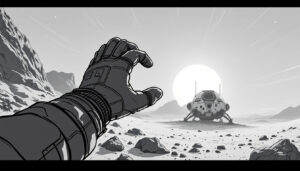
Traditional methods require sequential completion of planning tasks, creating bottlenecks that prevent parallel workflow development and rapid iteration capabilities essential for responsive client service. Script analysis, storyboard creation, shot list development, and sequence optimization must occur in specific orders, extending overall planning timelines significantly.
The sequential nature of traditional workflows makes accommodation of script changes and client revisions extremely disruptive and expensive. Simple modifications can require complete recreation of planning materials, often consuming more time than initial development while introducing additional opportunities for errors and inconsistencies.
Moreover, traditional planning approaches struggle with the compressed timelines that characterize modern commercial production, often forcing teams to skip essential preparation steps or accept compromised planning quality to meet delivery deadlines.
Shai Creative: The Revolutionary Alternative

Shai’s intuitive interface where users can upload a script and generate visual storyboards, complete with scene sequencing, shot duration, and voiceover options — all in one platform.
Automated Intelligence and Speed
Shai pre-production transforms planning workflows through AI automation that analyzes scripts and generates comprehensive visual plans automatically in minutes rather than weeks. The platform’s sophisticated algorithms understand narrative structure, character interactions, and cinematic principles to create professional-quality planning materials without manual intervention or artistic expertise requirements.
The speed advantage proves transformational for production teams managing multiple projects or responding to urgent client requirements. Script to storyboard generation occurs automatically, enabling same-day project visualization and rapid iteration capabilities that support responsive client service and efficient project management.
This automation eliminates traditional bottlenecks while maintaining professional quality standards that meet industry expectations consistently. Teams can focus their expertise on creative decision-making rather than technical implementation, maximizing the value of skilled personnel throughout project development phases.
Comprehensive Feature Integration
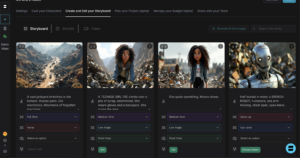
Shai storyboard view showing AI-generated frames from uploaded script
Unlike traditional approaches that require separate specialists for different planning aspects, Shai efficiency comes from integrated workflows that handle storyboard generation, shot list creation, and video preview development through unified AI systems. This integration ensures consistency across all planning elements while eliminating coordination challenges between different specialists and tools.
The platform’s comprehensive approach means that modifications propagate automatically across all connected elements, maintaining project coherence while accommodating necessary changes. Teams avoid the version control issues and communication gaps that commonly plague traditional multi-specialist workflows.
Additionally, integrated planning ensures that all elements support overall creative vision rather than reflecting individual specialist interpretations that may diverge from intended direction. This unified approach delivers more cohesive planning materials that guide efficient production execution.
Professional Quality at Scale
AI vs traditional pre-production quality comparisons reveal that automated systems often exceed manually created alternatives in consistency, completeness, and professional presentation standards. AI algorithms apply industry best practices consistently across entire projects, eliminating human error and subjective interpretation variations that affect traditional outputs.
The platform generates professional-quality visual content that rivals expensive artist-created alternatives while providing technical specifications and production guidance that manual approaches often overlook. This completeness enables confident client presentation and efficient production execution without requiring additional preparation or refinement.
Moreover, consistent quality across projects builds professional reputation and client confidence while reducing revision requirements that commonly occur with manual approaches. Teams can rely on predictable output quality that meets professional standards regardless of project complexity or timeline constraints.
Speed and Efficiency Comparison
Timeline Reduction Analysis
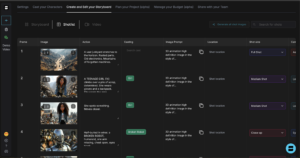
Shai Shot List Overview
Shai vs traditional methods timeline comparisons reveal 80-90% reductions in pre-production planning time without compromising output quality or comprehensiveness. Projects that traditionally require 2-4 weeks of specialist work achieve complete visual planning in 2-4 hours through intelligent automation.
These dramatic time savings enable responsive client service that provides competitive advantages in fast-paced commercial environments. Teams can respond to opportunities immediately while maintaining quality standards that impress clients and secure project success consistently.
The time efficiency also enables more thorough creative exploration and refinement within fixed project timelines. Rather than rushing through planning phases to meet deadlines, teams can invest saved time in creative development and optimization that enhances final project quality and client satisfaction.
Iteration and Revision Speed

Traditional revision cycles often consume as much time as initial creation phases, making creative exploration prohibitively expensive and time-intensive. Shai pre-production enables instant revisions and alternative approach generation without proportional time increases, encouraging creative experimentation and optimization.
The platform’s revision capabilities support responsive client collaboration by enabling rapid incorporation of feedback and immediate visualization of proposed changes. This responsiveness often improves client relationships while accelerating approval processes that determine project progression and success.
Additionally, rapid iteration capabilities enable comprehensive testing of different creative approaches before settling on final directions. This creative freedom often leads to superior outcomes that distinguish projects in competitive markets while maintaining efficient timeline adherence.
Workflow Parallelization Benefits
Shai efficiency enables parallel workflow development where multiple planning aspects progress simultaneously rather than sequentially. This parallelization further accelerates overall planning timelines while enabling comprehensive coordination between different project elements from initial development phases.
The parallel approach also enables team members to work on different aspects simultaneously without creating coordination conflicts or version control issues. This collaborative efficiency multiplies productivity gains while maintaining project coherence and creative vision alignment throughout development processes.
Furthermore, parallelization enables better resource utilization by eliminating idle time that commonly occurs in sequential traditional workflows. Teams maintain continuous productivity while achieving comprehensive planning coverage in minimal timeframes.
Cost-Effectiveness Analysis
Direct Cost Comparisons
Traditional pre-production costs typically consume 15-25% of total project budgets through specialist fees, extended timelines, and revision cycles. AI vs traditional pre-production cost analysis reveals 70-85% reductions in planning expenses while delivering superior results and comprehensive coverage.
A typical project requiring comprehensive storyboards and shot lists might cost $10,000-30,000 using traditional specialists, while Shai Creative’s monthly subscription costs less than a single day of professional storyboard artist fees. This dramatic cost difference enables budget reallocation to production areas that directly enhance creative quality and audience impact.
The cost savings prove particularly valuable for independent creators and small production companies operating with limited budgets. Professional planning capabilities become accessible regardless of project scale or financial constraints, democratizing high-quality pre-production across diverse creative communities.
Hidden Cost Elimination
Traditional approaches generate numerous hidden costs through coordination overhead, revision management, and workflow inefficiencies that compound throughout project lifecycles. Shai pre-production eliminates these costs through integrated automation that maintains consistency and eliminates manual coordination requirements.
Version control issues, communication gaps, and specialist scheduling conflicts disappear when using unified AI platforms that handle all planning aspects internally. Teams avoid the project management overhead and potential delays that characterize traditional multi-specialist workflows.
Additionally, improved planning quality reduces production inefficiencies and post-production complications that generate expensive corrections and timeline extensions. Comprehensive preparation prevents costly mistakes while optimizing resource utilization during actual filming phases.
Return on Investment Benefits
Shai vs traditional methods ROI analysis demonstrates that platform subscription costs typically generate returns within single projects through time savings, cost reductions, and quality improvements. The benefits compound across multiple projects, creating substantial long-term value for active creative professionals.
Improved planning quality often leads to better client satisfaction and project outcomes that generate referrals and repeat business opportunities. These indirect benefits multiply platform value beyond immediate cost savings and efficiency gains.
Furthermore, professional presentation quality enabled by AI planning tools often improves funding success rates and client acquisition effectiveness. Better project visualization leads to more successful proposals and enhanced competitive positioning in creative markets.
Quality and Professional Standards
Output Quality Comparison
AI vs traditional pre-production quality assessments reveal that automated systems often exceed manually created alternatives in technical accuracy, visual consistency, and professional presentation standards. AI algorithms apply industry best practices uniformly while eliminating human error and subjective interpretation variations.
Shai Creative’s storyboard generation produces visually sophisticated results that include appropriate camera angles, shot compositions, and technical specifications that rival expensive artist-created alternatives. The consistency across entire projects ensures cohesive visual planning that supports efficient production execution.
Traditional approaches often suffer from quality variations based on individual artist capabilities, interpretation differences, and communication gaps that affect final deliverables. AI automation eliminates these variables while maintaining consistent excellence across diverse project types and creative requirements.
Industry Standard Compliance
Shai efficiency includes automatic compliance with industry standards and best practices that manual approaches often overlook or implement inconsistently. The platform’s algorithms incorporate professional cinematographic principles while generating technical specifications that production teams require for effective execution.
Generated materials include proper formatting, standard terminology, and comprehensive technical details that facilitate seamless integration with professional production workflows. This attention to industry standards eliminates additional preparation requirements while ensuring team understanding and execution capability.
Traditional approaches may miss technical requirements or use non-standard approaches that complicate production coordination and team communication. AI automation ensures comprehensive coverage of all essential elements while maintaining professional presentation quality throughout planning materials.
Creative Enhancement Capabilities
Rather than limiting creative expression, Shai pre-production often enhances creative outcomes by providing comprehensive visual exploration capabilities that manual approaches make prohibitively expensive. The platform enables experimentation with multiple creative directions without proportional cost increases.
AI-generated suggestions and alternative approaches often inspire creative directions that creators might not consider independently. This collaborative aspect of AI assistance expands creative possibilities while maintaining human control over final creative decisions and artistic vision.
Additionally, comprehensive planning enables more ambitious creative execution by providing detailed roadmaps that support complex shot sequences and sophisticated visual storytelling approaches. Better preparation enables creative teams to focus on execution excellence rather than problem-solving during production phases.
Scalability and Flexibility Advantages
Project Scale Adaptation
Shai vs traditional methods scalability comparisons reveal that AI platforms accommodate projects ranging from simple social media content to complex commercial productions without requiring workflow modifications or additional specialist hiring. Traditional approaches often require different teams and processes for different project scales.
The platform’s scalable architecture provides appropriate detail levels and organizational structures that match specific project requirements and team capabilities. Small projects receive focused, streamlined outputs while larger productions benefit from comprehensive detail and sophisticated organizational features.
This scalability eliminates the need for multiple planning approaches and tool sets as creative businesses grow and project complexity increases. Teams can maintain consistent workflows while accessing capabilities that grow with their professional development and business expansion.
Creative Flexibility Support
AI vs traditional pre-production flexibility analysis shows that automated systems better accommodate creative evolution and client-driven changes throughout development processes. Traditional specialists often resist modifications that require significant rework, while AI platforms handle revisions seamlessly.
The platform’s revision capabilities enable comprehensive creative exploration without budget or timeline penalties that commonly accompany traditional modification cycles. This freedom encourages iterative refinement and creative optimization that improves final project outcomes.
Furthermore, AI video generation capabilities enable dynamic visualization of creative concepts that static storyboards cannot communicate effectively. This enhanced visualization supports better client collaboration and creative decision-making throughout development processes.
Technology Integration and Future-Proofing
Modern Workflow Compatibility
Shai pre-production integrates seamlessly with contemporary production tools and collaborative platforms while generating outputs in formats compatible with industry-standard software. Traditional approaches often require format conversions and manual integration that complicate workflow efficiency.
The platform’s cloud-based architecture supports remote collaboration and distributed team coordination that characterizes modern production environments. Team members can access and contribute to planning materials from any location while maintaining synchronization and version control automatically.
Additionally, export capabilities include multiple format options and comprehensive metadata that facilitate integration with various production tools and platforms. This compatibility ensures that AI-generated materials enhance rather than complicate existing team workflows and established production processes.
Industry Evolution Alignment
Shai efficiency positions users advantageously for industry evolution toward AI-assisted workflows that are becoming standard practice across creative industries. Early adoption provides competitive advantages while building familiarity with technologies that define contemporary production standards.
Educational institutions and professional development programs increasingly incorporate AI tools into curricula, recognizing their importance in preparing creators for current industry expectations and workflow requirements. Students and professionals gain valuable experience with cutting-edge approaches that enhance employment prospects.
The technology trajectory suggests continued advancement in AI capabilities while maintaining user-friendly interfaces and affordable access models. Platform investments provide long-term value that grows with technological development and industry adoption trends.
Professional Development Benefits
Using advanced AI planning tools accelerates skill development by providing exposure to sophisticated workflows and industry best practices that enhance professional capabilities and career advancement prospects. Get started with Shai Creative to access training and experience that distinguishes creators in competitive markets.
The educational aspect of AI assistance helps users understand industry standards and cinematographic principles through practical application rather than abstract study. This hands-on learning approach accelerates competency development while maintaining creative engagement and project productivity.
Furthermore, mastery of AI-assisted workflows positions professionals advantageously for industry changes and
